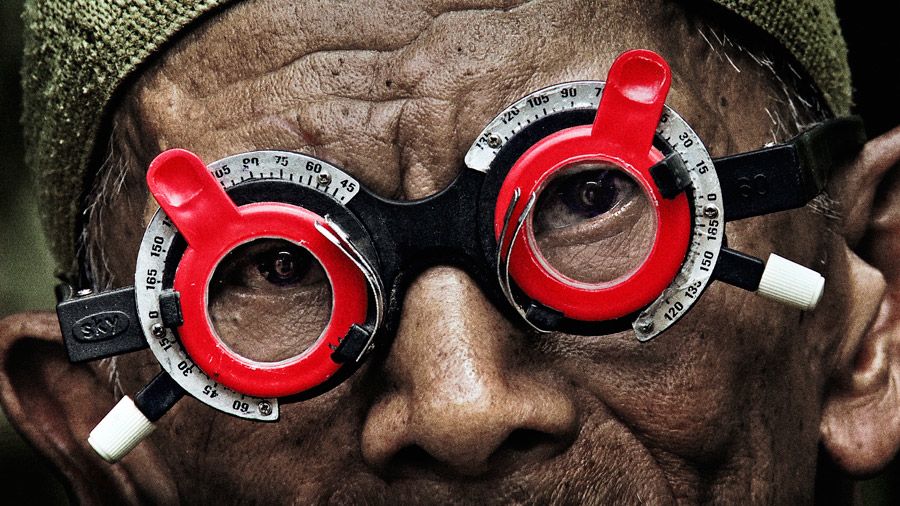Absent Victims ( Joshua Oppenheimer, the director of The Act of Killing )
January 26, 2015
Joshua Oppenheimer, the director of The Act of Killing, discusses his follow-up documentary, The Look of Silence, about those who survived the Indonesian genocide of 1965
By Joshua Jelly-Schapiro

Adi tests the vision of a death squad leader who helped kill his brother. Photograph by Lars Skree © Final Cut for Real
When a new documentary by an unknown director appeared on the program of the 2012 Telluride Film Festival, few knew what was in store. The fact that two celebrated auteurs—Werner Herzog and Errol Morris—had attached their names to the project as executive producers hinted at its distinction. But even by their standards, and those of a film festival renowned for premiering the finest films of the year, Joshua Oppenheimer’s The Act of Killing was astonishing work. Its subject was one the least-known genocides of the twentieth century, the awful months in Suharto’s Indonesia, between the fall of 1965 and the spring of 1966, when at least half a million suspected Communists and sympathizers—along with artists, intellectuals, and residents of the wrong village—were slain by a regime with ties to a Cold War-era CIA. But unlike most historical documentaries, Oppenheimer’s film wasn’t concerned so much with exposition, with establishing the hard facts of the atrocities. The young American director instead took a radical tack: he turned his camera on the perpetrators. He asked a charismatic crew of aging killers, none of whom have ever had to answer for their roles in the genocide, to reenact their crimes on film. In doing so, they employ film noir tropes, footage of majestic waterfalls, and music-video kitsch involving giant plastic fish. The result offers us a rare glimpse at the tales mass murderers tell themselves to cope with their ruthless pasts.
Since its launch, The Act of Killing’s bevy of prizes and plaudits has grown to include a BAFTA and an Oscar nomination for best documentary. More remarkably, it has “opened a space for conversation,” Oppenheimer says, in a country that has yet to collectively reckon with this dark chapter of its history. The conversation continues in his new film, The Look of Silence, which considers the genocide from a different perspective. Whereas The Act of Killing examines the lasting impacts of violence through the narratives of its perpetrators, Oppenheimer’s follow-up focuses on victims. Less radical and more intimate than its predecessor, The Look of Silence, which will be released in June, tells the story of a village optometrist, Adi Rukun, who lost his brother to the genocide. We follow Rukun into the home of his aging parents, and then into the lush yards and houses of similarly aged killers nearby, where he questions the transgressors with gentle force—often while giving them eye exams—about not-forgotten crimes.
In Telluride, where The Look of Silence was screened, public radio journalist Mirissa Neff and I interviewed Oppenheimer about his craft and his decade-long, two-film project which, a couple of weeks after we spoke, earned him a MacArthur fellowship.
It seems fair to say that The Look of Silence and The Act of Killing aren’t so much two discrete pieces as they are two parts of a single project. How did this larger project come about?
remainder:http://harpers.org/blog/2015/01/interview-with-joshua-oppenheimer/